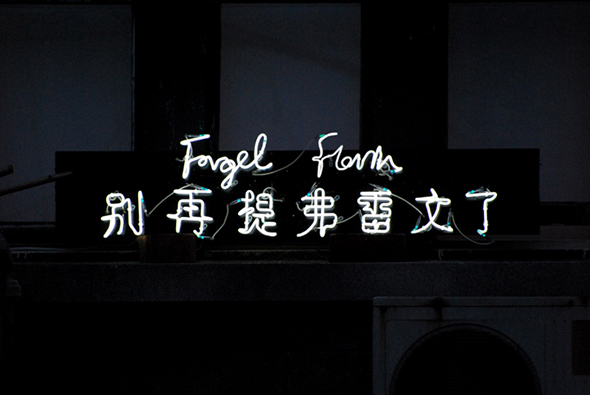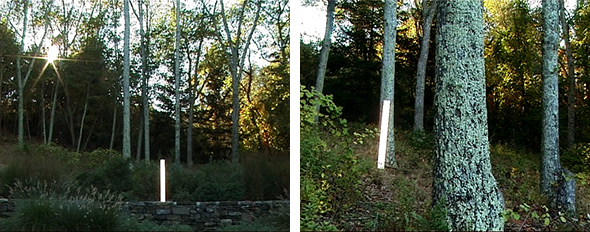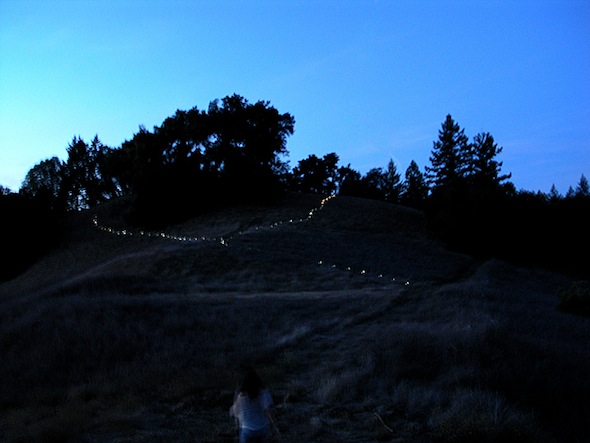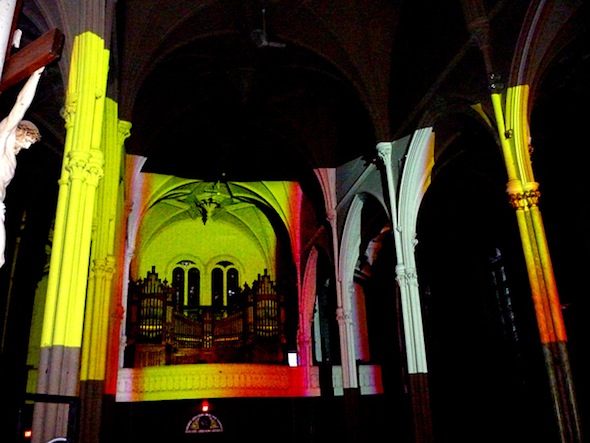Article by Sarah Corona in New York; Tuesday, Apr. 8, 2014
From Goethe to Octavio Paz, from James Turrell and Dan Flavin to Douglas Wheeler, they are all trying to get to one thing: light, in all its shapes and colours. Light as an object, as an architectural element. Light as a philosophical motto. Light as a political and moral frontier.
That is to say, “Light writes always in plural,” for its range is boundless. It occupies space and seeps everywhere — like water – altering it physically and psychologically.
 Anne Katrine Senstad – “Forget Flavin” (2008), neon tubes, transformer; collection of Zendai Moma, Shanghai
Anne Katrine Senstad – “Forget Flavin” (2008), neon tubes, transformer; collection of Zendai Moma, Shanghai
The media that Anne Katrine Senstad uses to express her ideas range from neon installations to projections, from photographic printing to site-specific land art. Senstad inserts light and luminous bodies in everyday spaces, whether exterior or interior, inhabited or not. And these physical places often serve as messengers from a world in which human emotions and existence are reduced to a minimum.
And it’s precisely the neon work Light Writes Always in Plural which opens the discourse on the artistic production of Senstad. Inspired by the title of Octavio Paz’s essay “Water Writes Always in Plural,” on the art of Marcel Duchamp, the neon work not only emanates its bluish light into all crevices, but it is also a witty play on words and concepts about philosophy and life. Underlying this florescent tube is a careful analysis and critique of our use of language as a means of mass communication.
 Anne Katrine Senstad – “Light Writes Always in Plural” (2008), neon tubes, transformer
Anne Katrine Senstad – “Light Writes Always in Plural” (2008), neon tubes, transformer
The literature and philosophy of the great thinkers have inspired other neon works by Senstad. Forget Flavin comes from the title of Baudrillard‘s “Oublier Foucault” (1977), simultaneously an ode to and critique of Foucault that remains unanswered. Senstad appropriates Baudrillard’s concept, declaring through the artwork her admiration and antagonism of the American minimalist artist. Translated into Chinese characters, the title takes on a significance beyond visual translation that reflects the charged relationship between image and word. A third example is Light Owes Its Existence to the Eye, a quote from Goethe and a reference to his obsession with light and colour. The works and phrases in neon become a subliminal reminder and visual symptom of an intellectual concept, translated into tangible objects.
Senstad’s installations in nature, or land art, take on a political twist. A prime example is The River of Migration (2010), comprised of 72 lights planted in a hilly Californian landscape in order to create a line that interferes with the local geography. It is not just an intervention in the landscape, but a strong gesture of opposition to the policies of migration — a silent memorial to those who have lost their lives trying to cross the U.S.-Mexican border. The solar-powered lamps represent the victims of 2010, the year she realized the project. The long line of lights down a hillside talks about the nature of migration and how bodies of people crossing long distances will naturally walk in a sequential manner according to age, physical health, group importance, and their delegated task. The phenomena of artificial lights in a natural, untouched landscape evokes notions of light and darkness, nature and the artificial, the environment and the untouched landscape, providing a scenario for interaction and intervention.
 Anne Katrine Senstad – “The River of migration”, (2010), video still, 4.53 min
Anne Katrine Senstad – “The River of migration”, (2010), video still, 4.53 min
The works with which Anne Senstad most captures the attention of the viewer are the large environmental installations. Through the projection of coloured lights, she tints entire spaces in red, blue, yellow, green, and all shades in between. Combined with specifically composed sound, the visions of colour create a visual poetry leading the viewer to a sensory experience approaching a synaesthetic phenomenon. “The optical illusions experienced when physically enveloped in artificially projected colours, shapes, and sound,” Senstad explains, “give way to the momenta of kinesthesia.” Such is the experience of her work Kinesthesia for Saint Brigid (2011-12), an installation consisting of a continuous projection of colours in a former church in Ottawa (Canada). Accompanied by pulsating background music, composed by JG Thirlwell, the work gives rise to a transcendental experience of art. “It’s about creating life in an enclosed and uninhabited space,” says Senstad. Inspired by Plato’s “Cave and Pharmakon,” the sensory and perceptive aesthetics are combined with spatial relations, structures of architectonic spaces, and retinal experiences of the prisoner’s cinema.
 Anne Katrine Senstad – “Kinesthesia for Saint Brigid” (2011), video still
Anne Katrine Senstad – “Kinesthesia for Saint Brigid” (2011), video still
Evolving from this work is Universals (2013), exhibited as part of the 55th Venice Biennial of 2013. A polygon made of transparent plexiglass tubes inhabits the center of the exhibition space and is continuously exposed to fields of coloured light. Divisive fields of projected light, and the subsequent re-assembling into a solid, create the sculpture. The work challenges the boundaries of architecture, video, and traditional concepts of sculpture and strengthens Senstad’s ideas of using light and colour to solidify space. A similar concept is expressed in her photographic prints, where we can observe foldouts of hypothetical sculptures — impossible solids made of coloured rays, visible only “thanks to a perfect combination between the distribution of shadow and light reflected from a transparent object.” (Goethe)
___________________________________________________________________________________
Additional Information
See more of Anne Katrine Senstad’s work
Anne Senstad
___________________________________________________________________________________
Sarah Corona holds a BA in Fine Arts and a MFA in Communication and Management of Art (University of Bologna). Based in New York, she works as independent curator, art historian and journalist for international art magazines with a focus on the intersections between technology and art. www.sarahcrown.com























